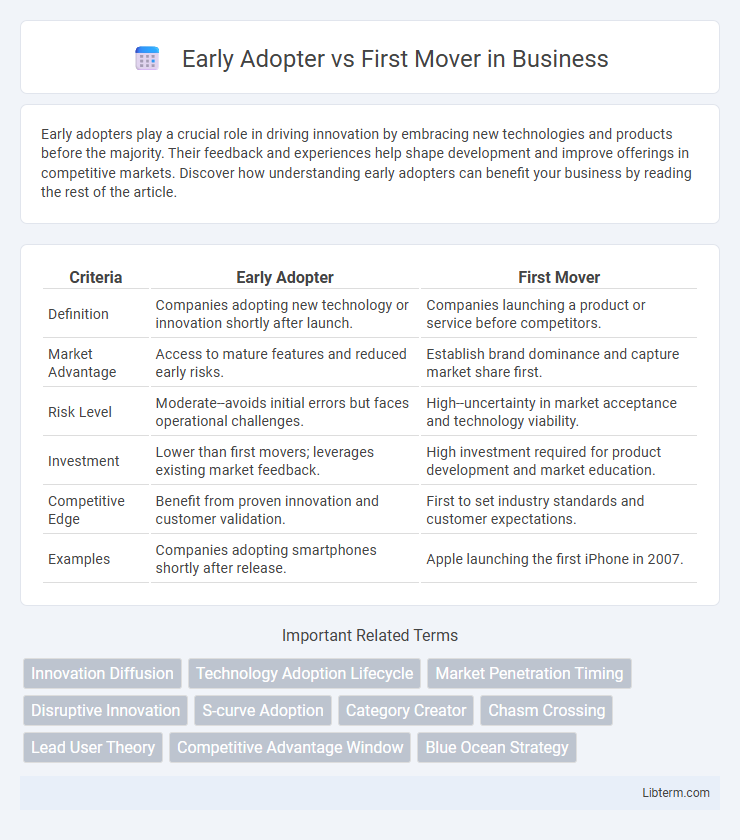Early adopters play a crucial role in driving innovation by embracing new technologies and products before the majority. Their feedback and experiences help shape development and improve offerings in competitive markets. Discover how understanding early adopters can benefit your business by reading the rest of the article.
Table of Comparison
| Criteria | Early Adopter | First Mover |
|---|---|---|
| Definition | Companies adopting new technology or innovation shortly after launch. | Companies launching a product or service before competitors. |
| Market Advantage | Access to mature features and reduced early risks. | Establish brand dominance and capture market share first. |
| Risk Level | Moderate--avoids initial errors but faces operational challenges. | High--uncertainty in market acceptance and technology viability. |
| Investment | Lower than first movers; leverages existing market feedback. | High investment required for product development and market education. |
| Competitive Edge | Benefit from proven innovation and customer validation. | First to set industry standards and customer expectations. |
| Examples | Companies adopting smartphones shortly after release. | Apple launching the first iPhone in 2007. |
Understanding Early Adopter and First Mover Concepts
Early adopters are individuals or organizations that embrace new technologies or products shortly after their launch, playing a crucial role in validating and spreading innovation within target markets. First movers are companies that introduce a product or service to the market before competitors, gaining advantages such as brand recognition, customer loyalty, and control of resources. Understanding the differences highlights how first movers leverage pioneering status while early adopters drive market acceptance and refinement of innovations.
Key Differences Between Early Adopters and First Movers
Early adopters are customers or users who embrace new products or technologies shortly after their launch, while first movers are companies or organizations that introduce an innovative product or service to the market before competitors. The key difference lies in market timing: first movers gain competitive advantage through innovation leadership and brand recognition, whereas early adopters influence market acceptance and provide valuable feedback that shapes product refinement. First movers often face higher risks and costs associated with market creation, while early adopters benefit from reduced uncertainty and improved product maturity.
Advantages of Being a First Mover
First movers enjoy significant advantages such as strong brand recognition and customer loyalty, often capturing substantial market share before competitors enter. They can set industry standards and benefit from economies of scale, creating higher barriers to entry for later entrants. Pioneering innovation also allows first movers to capitalize on unique intellectual property and establish critical supplier and distributor relationships early on.
Risks Faced by First Movers
First movers face significant risks including high research and development costs, uncertainty in market acceptance, and the challenge of educating consumers about new products or technologies. They often invest heavily without guaranteed returns, while competitors can learn from their mistakes and enter the market with improved offerings. Market dynamics and shifting consumer preferences can further expose first movers to the threat of faster followers capturing larger market shares.
Benefits of Early Adoption
Early adopters gain significant competitive advantages by accessing innovative technology or products before the mass market, enabling them to influence product development and shape industry standards. They benefit from increased brand recognition and customer loyalty by positioning themselves as leaders and visionaries in their field. Early adoption also allows companies to gather critical user feedback, refine offerings, and accelerate learning curves, leading to improved market positioning and long-term growth potential.
Challenges Early Adopters Encounter
Early adopters face significant challenges such as higher costs due to unproven technology and limited support infrastructure. These consumers often encounter risks like frequent product updates and potential compatibility issues with existing systems. Their feedback is crucial for refining innovations, but early adopters must navigate uncertainties that first movers, who invest heavily in market entry, may manage differently.
Case Studies: First Movers vs Early Adopters
Case studies reveal that first movers, like Amazon in e-commerce, often gain significant market share by establishing brand recognition and customer loyalty early, but face high risks and costs of innovation. Early adopters, such as Netflix in streaming services, capitalize on improved technologies and market validation to scale quickly with reduced risk and adaptable strategies. Comparative analysis shows that early adopters frequently achieve sustainable growth by leveraging first mover mistakes and refining business models for evolving consumer demands.
Market Impact of First Movers and Early Adopters
First movers create significant market impact by establishing brand recognition, setting industry standards, and securing key resources, often influencing customer preferences and supply chains. Early adopters accelerate market penetration by validating innovations and providing crucial feedback, which helps refine products and drives broader market acceptance. The combination of first movers' pioneering efforts and early adopters' influential support shapes competitive dynamics and long-term market success.
Strategies for Success: Early Adoption or First Mover?
Early adopters gain competitive advantage by quickly integrating innovative technologies and responding agilely to market feedback, which reduces risks associated with unproven products. First movers benefit from establishing strong brand recognition and customer loyalty by capturing market share before competitors, but must invest heavily in education and infrastructure development. Strategic success depends on aligning organizational capabilities with market readiness, where early adoption suits adaptable firms in fast-evolving industries, while first-mover strategies thrive in markets with high entry barriers and scalable demand.
Choosing the Right Approach for Market Entry
Choosing the right market entry strategy hinges on understanding the differences between early adopters and first movers. Early adopters benefit from observing market feedback and refining products before full-scale launch, minimizing risks and capitalizing on proven demand. First movers gain brand recognition and can establish dominant market share but face higher uncertainty and development costs without prior market validation.
Early Adopter Infographic

 libterm.com
libterm.com